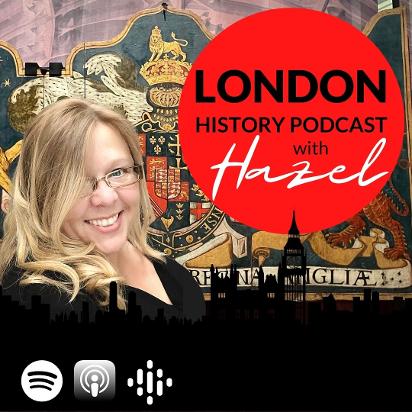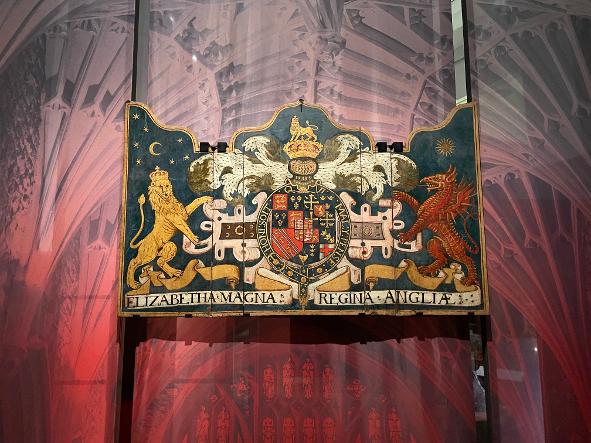
Episode 76: Elizabeth and Mary: Tudor Cousins
Join Hazel Baker as she talks with Dr Daniella Gonzalez about the latest exhibition at the British Library: Elizabeth and Mary: Royal cousins, rival queens.
In this episode we look at two of the most powerful women in Tudor history; Elizabeth I and Mary Queen of Scots. Their relationship was a complicated one. They were royal cousins and rival queens. Extraordinarily the women never actually met and yet their lives were entwined. We take a look at their story as presented in the British Library's latest exhibition.
Listen Now: Apple Podcasts | Spotify |Android |RSS
Get our latest episode in your inbox here
Recommended Reading
Elizabeth & Mary, British Library, Edited by Susan Doran
Anne Boleyn and Elizabeth I: A Mother-Daughter Moment Through Time, Kate McCaffrey
Exhibition Info:
Elizabeth and Mary: Royal Cousins, Rival Queens
Open until Sun 20 Feb 2022
Hazel is an active Londoner, a keen theatre-goer and qualified CIGA London tour guide.
She has won awards for tour guiding and is proud to be involved with some great organisations. She is a freeman of the Worshipful Company of Marketors and am an honorary member of The Leaders Council.
She has been an expert guest on Channel 5's Walking Wartime Britain (Episode 3) and Yesterday Channel's The Architecture the Railways Built (Series 3, Episode 7).

Today's Guest: Dr Daniella Gonzalez
Dr Daniella Gonzalez is a medievalist who completed her PhD in Medieval and Early Modern Studies at the University of Kent in 2020. Since then, Daniella took on a Social Media Fellowship with the British Association for Local History between August 2020 and August 2021. Daniella is an archive professional and currently works as a Cataloguer on the Prepare and Move project based at the Parliamentary Archives.


Show notes:
Hazel Baker: Hello and welcome to our London history podcast, where we share our love of London, its people, places and history. This podcast is designed for you to learn things about London that most Londoners don't even know, all in 20 minutes. I am your host Hazel Baker, qualified London tour guide and CEO of www.londonguidedwalks.co.uk
Our walking tours are for those who love London and want to make the most of their time here, no matter whether it's for a weekend or a lifetime. We aim to deliver insightful and well-prepared London guided walks with genuine enthusiasm and professionalism. And in this podcast, we try to do exactly the same.
Get that cup of tea, put your feet up and enjoy!
Hazel: Today's episode is about an exhibition, Elizabeth I and Mary, Queen of Scots at the British Library. The strap line is Royal Cousins and Rival Queens. It's on all the way up to the 20th of February 2022. You can get tickets; £16 for full price, members are free. If you've got an artfund pass like me, then you can get it for £9. Other concessions are available.
Joining me today to discuss this exhibition is Dr. Daniella Gonzalez, a medievalist who completed her PhD in Medieval and Early Modern Studies at the University of Kent in 2020. Since then, Daniella took on a Social Media Fellowship with the British Association for Local History between August 2020 and August 2021. Daniella is an archive professional and currently works as a Cataloguer on the Prepare and Move project based at the Parliamentary Archives.
Hazel: I am still buzzing about seeing this exhibition. Daniela, I don't know about you?
Daniella: I completely agree. So at the start of January and every chance that I get we're friends with work colleagues, I'm like, please go see this exhibition. It's fantastic. And I love when I'm scrolling through Twitter, that people are talking about the exhibition.
I've seen a number of blog posts about it from various academics, working on queenship for example, or working on the queens themselves. So. It's really good to see that it's basically out there, people are enjoying it and it really is being celebrated for being an absolutely astounding exhibition.
Hazel: What I found refreshing about this exhibition was the story of Elizabeth and Mary was the main feature. It's often treated as a subplot or a sideline in historical fiction, or indeed in a period drama. And the focus was entirely on these two; these two queens.
Daniella: As you were in saying, there's so much scholarship on Elizabeth, on Mary, on various aspects of, of their reigns but actually this is the first exhibition that looks at them together kind of looking at their separate lives, but also seeing how these Queens interacted, despite the fact that they never actually actually met. And it is funny that you mentioned. Historical dramas. Anybody who's watched Mary Queen of Scots will see that at the end, they do have a, a meeting when Mary crosses over to England following the murder of Darnley and basically being ousted her from her throne. That never happens, but it is nice to finally see them considered as women and as queens respectively.
Hazel: I think that's really important. I do think when I was going through the exhibition, I did that if these two women were just able to get together and talk, as cousins should be able to, maybe it wouldn't have ended up.
Daniella: Yeah, it always is that 'what if' question isn't it. And I think one of the things that really comes to light in the exhibition is obviously we see these letter exchanges between the two women, but kind of thinking lots about who actually is writing these letters, even though the Queens are signing them off themselves.

Elizabeth I
Unknown artist, late 1580s
Private Collection
This is the one Dr Gonzalez is talking about

Elizabeth I when c. 34 yrs old when marriage negotiations were in full swing.
Portrait attributes to George Gower c. 1567
Private Collection
And also as you go throughout the exhibition, you see various names. For example, William Cecil, Lord Burley, a very key figure in Elizabeth courts. So. Did you kind of think a little bit about who was influencing them? What was driving politics and the people they surrounded themselves with? I think that has a very big part to play in this story, especially in the later 1570s and eighties, when we see various plots against Elizabeth in which Mary is implicated.
And of course that's what leads to her execution at Fotheringhay castle in 1587. And we see key players such as Francis Walsingham involved in. William sessile and the kind of people within parliament kind of really pushing for Mary's execution. I mean, you see it in the exhibition that Elizabeth herself is reluctant. Lots to think about the influence of others on their decisions and what is going on.
Hazel: It's worth remembering that the privy council can be considered like a filter. I mean, we're talking about a fluctuating number of members for Elizabeth's privy council, somewhere around 13, or even going up to 16 at the end of her reign. This small number of men who aren't always with her, who have their own agendas too, they are the ones with access who can control what goes in and also what comes out.
Daniella: Exactly. And we do see some kind of continuity later and Elisabeth's frames in, in terms of who she surrounds herself with. So after William Cecil, Lord Burley dies to son Robert Cecil who's very much a kind of prominent figure.
Very much kind of in the position that his father's wife. And we do see Robert Cecil, for example, corresponding with, with James in the final years of Elizabeth's life. I do think these privileged privy councillors had a very key role we need to consider.
Hazel: So let's get into that exhibition because what I loved is walking down the steps and being fully immersed in the Tudor world. I was in there for two and a half hours. Admittedly, I went on my own because I knew that no one else would be fine with me. I think you might be.
Daniella: Yeah, I do always try to pick who I go to exhibitions of very carefully, because I do read everything. And mind the person, please have patience.
If I want to look at it all, especially in such an exhibition as Elizabeth and Mary, Royal Cousins, Rival Queens, the range of collections was absolutely fantastic. I was absolutely astounded by the variety of material that the British Library have in their own connection. And also collections from the National Archives, for example I loved to see Henry VIII's will. That gave me fond memories of being a PhD student and going to the national archives and working with the teams there to get some extra postgraduate archival training. So that brought back some good memories. Items from Lambeth palace library, for example, such as the execution warrant for Mary . And I thought it was great to see material even from private collections, for example, there's this absolutely beautiful painting of Elizabeth towards the end of the exhibition. It's by an unknown artist, possibly may have been made to be put in a Guildhall or commissioned from a Guildhall. But it's great to see that even private collectors have loaned their items to the exhibition. There's something there for everyone.
There's different media; written material there's objects such as pendants. And of course, as you're leaving the exhibition, as you know, there's those two absolutely fab replicates of both Mary and Elizabeth teams, which are Westminster Abbey, which are just across the road from me at the moment. Yeah. I, I must admit, I did love the variety.

Elizabeth I's gold locket ring with rubies and diamonds (as mentioned in podcast)
Unknown maker, c. 1575
Chequers Trust

Gold phoenix pendant, notice the red and white roses for the Tudor dynasty.
c. 1570 - 80
British Museum, SLMisc. 1778
Hazel: That painting. I'd never seen that painting before and the way it was displayed was so dramatic; set with a red wall and she's in the red dress, and strawberry blonde hair and would call it now. That was very dramatic. And I think you're quite rightly say that with private collections contributing to it added another level. Because they know it's an important subject , it's an important story to tell.
Danielle: Exactly. And I think kind of the curators, every exhibition needs to be commended on this. Just the sheer task of looking for these items and thinking about security, where to place it and just gathering it and the way that they've used it to tell the Queen's lives.
I mean, kind of going back to this painting, for example, just kind of at the very end of the exhibition, I think really exemplifies the Gloriana myth around Elizabeth that even kind of in the 1590s, 1600s, when she's much older, we have to remember when she dies. I think she's about 60. And it's in the 1590s when Elizabeth faces the greatest years. There's conflict of Ireland, there's famine, there's lots of problems. We get these images of Elizabeth, kind of towards the end of the reign, and she's remembered for, you know, her golden age, the great Elizabeth, and there is this fantastic portrait, other portrait of Elizabeth called the rainbow portrait. And seeing that painting of her in the beautiful, stunning, vibrant, very rich dress made me think about that as well. And kind of other collections that you can use to tell this story.
Hazel: I thought that was just fantastic and it really kind of taps into these like key elements and key themes of this period. Another thing that I have in light is seeing the handwriting could be the signatures. But just because, because of historical figures, you learn about them at school. There are a presence in our history. And so we carry them. But when you actually see how they've written and especially when she writes to James I you do get that sense of a real person. You don't get just by watching a documentary or reading it, perhaps, paraphrased it a book, for example, and to see it real as well, you know, the ink on that parchment that got me very excited.
Danielle: I think it's definitely humanises them. I have to say, whenever I see signatures from monarchs, I'm like "this is so cool. Like they've touched this." And there really isn't an element of that, but I do think you are right. It doesn't humanise them the way that they sign off the way that they refer to each other as sisters.
One of the things I did really like Mary Queen of Scots letters is that they're written. In French. And of course she becomes queen very, very young, but she does go to France. So it's quite interesting to kind of see that element. She's basically being brought up in France and, I assume, spoke fluent French. So I find it absolutely interesting that she's writing in French.
I do have to have to say with their writing it does take a certain set of skills to, to read them. You need to be trained in paleography. So there were points where I thought, oh I think the exhibition was so accessible. I thought it was great. The descriptions they gave, I thought the audible points were fantastic. You know, you can hear Elizabeth Tilbury speech, for example, but I definitely, I was like, oh, it'd be really great to have a few, some transcriptions. People if they, if they are really interested in a particular letter, what the subject matter is, is explained.
It would be really cool actually to be able to read it line by line. But I regard, regardless of art, I think it's still so impressive to see, to see the script and see how they wrote and see all these wonderful letter exchanges. For example, there's loads of correspondence, which. Really great. And kind of demonstrating Anglo Scottish relations in this period.
And of course, as I was saying to you, before we, before we started, it is absolutely fantastic to see in the early stages of the exhibition, that poem about the marriage of Henry VII and Elizabeth of York by the Italian. Geeky. I've probably mispronounced that. So I do apologise. But even kind of seeing that script and seeing how it changes over time, I thought was it's fascinating.

Cipher used by Mary Queen of Scots and Anthony Babington
July 1586
On loan from the National Archives, UK, SP 12/193/54

Both Elizabeth I and Mary, Queen of Scots had trusted clerks to lock their letters on their behalf.
Find out more at the Unlocking History Research Group
Hazel: And it's really great to share that with everyone. I think it was nice that they kind of started with that. And then they also end with a poem from Mary.
Daniella: Yes. I thought that was really kind of great just before she's executed kind of, I mean, this is one thing that I thought was great with the exhibition is that you really kind of can follow her life very, very closely, like from the moment she's in France until the moment of her execution and what I found impressive because I felt when I was going through it, I was like, "oh, this keeps going on. This is fantastic". But the story does continue. Mary has her son James, and obviously, until the final of Elizabeths' reign I really liked that ending. Obviously it ended with the two Queens.
One of the final items I saw was the Basilikon Doran. That text, I think really kind of has ideas about James's kingship in that. So I just thought that was really great. And actually that was something that he wrote for his son as well. So even though Mary is obviously no longer around, she was executed in 1587, it's interesting to see her line continue.
And of course Elizabeth dies in 1603. James I comes to the throne. So the Stuart dynasty continued well into the 17th century. We have, of course, a little break known as the interregnum period.
Hazel: And talking about breaks. I want to say thank you to the curators who decided to put benches in the exhibition, and not just with one at the end for the weary plus ones. There were a few times where there was something that I'd read and I'd had that little light bulb moment and I just needed to sit down and contemplate.There is so much to see here and so much to learn and because it wasn't all letters, you weren't just bending down to look at down. You were, you were looking up at the pictures of the banners and the way that they had created the false walls. That was so well done. I spent a lot of time looking at the old maps of Tudor London as well.
Daniella: I have to say that one is as a historian of medieval London. That was a favourite of mine. I do have to say there were some great maps in that exhibition, other than that of London. Of course I'm biased but there were maps of Tudor Scotland and Derby and Kent. And even I thought towards the end, when you see this map, it shows the kind of different light beacons that they lit or at the time of a Spanish Invasion (MS 62935). Not only does it tell you so much about the landscape of Tudor England. I thought that map was really interesting to kind of see how those are used at a key moment. And it also tells you about political anxieties at the time of the fact that they, that they had to have that. But I thought that again, thinking about the different media they have. Such a great range of kind of visual items, whether they were maps, paintings and again, lots of great written sources.
There were some absolutely fantastic printed sources as well. And I'll have to say I've got very excited, seeing a copy of John Foxe's 'Book of Martyrs' (British Library G.12101,. pp 1502-3) and Henry VIII Great Bible (British Library, C.19d.10). When I was at the university of Ken as a doctoral student, I taught lots of early modern modules and the Protestant reformation, the counter reformation and kind of religion and Elizabeth I and Mary Queen of Scots, kind of thinking about what happens when the Scottish reformation comes around. So I was so excited.
I'd only ever with regards to John Foxe's 'Book of Martyrs' I'd only ever showed students and PowerPoints images from that text. So I was over the moon. I was like, "I finally get to see a copy" and I taught this and the students loved it. There was the page that showed the burning of Archbishop Thomas Cranmer. I was like, "this is even better." I had seen the image before kind of on online sources, but I was like, "this is the best. It doesn't get much better than actually seeing the item" As a caveat, I do work as an archive professional, so I am around primary sources all day, but yeah that excitement never, ever, ever goes away. Please go and see it!

Elizabeth I's and Mary, Queen of Scots tombs lie side by side in the British Library. The royal cousins both lie in Westminster Abbey, just not side by side.

Paper was used to reflected the beautiful fan vaulted ceiling in Westminster.
Hazel: What was nice was that because of the vast array of materials that they had, some of them were so unexpected. A lot of them I had read about them but I was like "oh, yes, I know, I know this existed and now it's real. And like you were saying about Henry VIII's Great Bible. Yes, of course he had one, and I think I've seen it on a documentary, but seeing his scribbles, seeing the actual ink in that book, his doodles and comments. I mean, that was just brilliant.
Daniella: Oh, definitely. I completely agree. And I have to say again, at the start of the exhibition, seeing Elisabeth I's ring which I believe is, has been loaned by the Chequers Trust. I've only ever seen images of that and seeing the image of Anne Boleyn and Elizabeth I herself, but seeing it in person, it's absolutely stunning. It's a beautiful ring that really exemplifies the relationship or the emotions that Elizabeth had towards her mother. I was just gobsmacked for that. I was like, "this ring is so cool".
Hazel: That ring was stunning. I don't, I think it would fit on my little finger! For those who don't know what we're talking about I have photos galore in the show notes of this episode page, including of this ring.
To describe the ring: when the ring is closed, it has a beautiful diamond E and a blue R (for Elizabeth Regina), and then she can open the ring (and it's tiny) and in there there's a portrait of herself, but also one of her mother Anne Boleyn. And don't forget, she wasn't even three when Anne Boleyn was taken to the Tower of London and later executed. So, she might not even have a memory of her mom. This was a mom that she never talked about and yet her mom was always with her.
Daniella: It does say so much about that closeness. I mean, for any listeners to this podcast, if you want to find out a little bit more about Anne Boleyn and her connections to other women and also connections through these women to whomever Elizabeth definitely check out recent work done by Kate McCaffrey. She looked at an abundance of books at Hever Castle. I won't say any more but definitely have a read for yourself. Do have a look at that if you want to find out a little bit more about Elizabeth's mother Anne Boleyn and women's history.
Thank you Dr Daniella Gonzalez for your time today.
That's all we got time for. See you next week!

Elizabethan London
William Smith, profile and bird's-eye view of London, Southwark and Westminster, 1588
Sloane MS 2596, f. 52or
You can also buy a copy of this from the British Library (like I did!)

Elizabeth I's last letter
Elizabeth wrote to James VI of Scotland on 5 January 1603 when at Richmond Palace. Look how there isn't enough room for her signature and how wild her writing style is compared to that of when she was younger.
Additional MS 18738, f. 40v
Other Episodes
075: Christmas Crackers - a Victorian Invention
074 Christmas in 1950s & 1960s London
073 Great Ormond Street Hospital
072 Drs William and John Hunter
069 Victorian Actor William Terriss
067 London Street Names: Food Edition
064 Medieval Toilets in London
062 James Scott, the First Duke of Monmouth
061 Medieval London at the Museum of London
060 Virginia Woolf & The Bloomsbury Set
058 Greenwich Palace and Hospital
057 The Gerald Coke Handel Collection
053 Benjamin Franklin in London
051 Walk Through London's Forgotten Places
047 Victorian Dinosaurs in Crystal Palace Park
046 Beer, The Bard & Historic Buildings of Bankside
045 Drawing London's Buildings
042 John Julius Angerstein: The Man Behind the National Gallery
041 London's Medieval Friaries
040 Charles Dickens in Greenwich
038 The Black Death: London's First Plague
037 Bridgerton & Regency London
034 London's Old Shops - Food & Drink
031 Abandoned London Underground Stations
030 Quirky Street Names - Little Britain
029 The Harp maker of Fitzrovia
024 The Walbrook in Roman London
021 London Area Names - Animal Edition
020 The Great Fire of London - How It Began
017 The Proms & The Royal Albert Hall
016 Women in 1920s London (From Cowgirl to Congress)
014 Postcards From London's Past
013 London Statues: Medical Women
012 The Old Operating Theatre Museum
011 London's Coffeehouses and Commerce
009 Music Halls and Cabaret - from yesterday to today
008 The Monument to the Great Fire of London
006 Hockley in the Hole Clerkenwell
Some links contain affiliate links, which means that if you click on one of the product links, we receive a small commission. This helps support our free podcast. Thank you for the support!
Copyright London Guided Walks and Treasure Hunts

